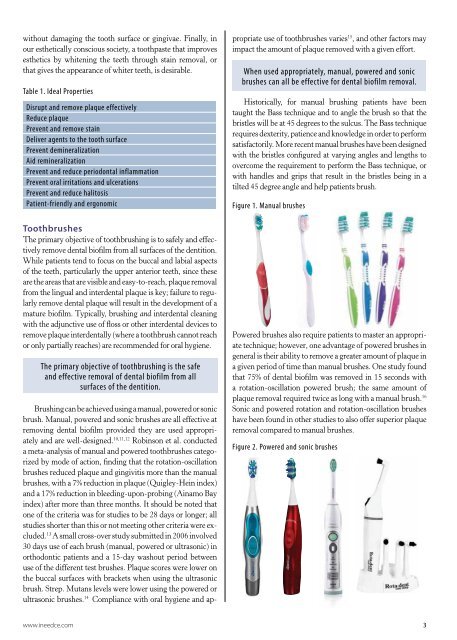Toothbrush technology, dentifrices and dental biofilm ... - IneedCE.com
Toothbrush technology, dentifrices and dental biofilm ... - IneedCE.com
Toothbrush technology, dentifrices and dental biofilm ... - IneedCE.com
Create successful ePaper yourself
Turn your PDF publications into a flip-book with our unique Google optimized e-Paper software.
without damaging the tooth surface or gingivae. Finally, in<br />
our esthetically conscious society, a toothpaste that improves<br />
esthetics by whitening the teeth through stain removal, or<br />
that gives the appearance of whiter teeth, is desirable.<br />
Table 1. Ideal Properties<br />
Disrupt <strong>and</strong> remove plaque effectively<br />
Reduce plaque<br />
Prevent <strong>and</strong> remove stain<br />
Deliver agents to the tooth surface<br />
Prevent demineralization<br />
Aid remineralization<br />
Prevent <strong>and</strong> reduce periodontal inflammation<br />
Prevent oral irritations <strong>and</strong> ulcerations<br />
Prevent <strong>and</strong> reduce halitosis<br />
Patient-friendly <strong>and</strong> ergonomic<br />
<strong>Toothbrush</strong>es<br />
The primary objective of toothbrushing is to safely <strong>and</strong> effectively<br />
remove <strong>dental</strong> <strong>biofilm</strong> from all surfaces of the dentition.<br />
While patients tend to focus on the buccal <strong>and</strong> labial aspects<br />
of the teeth, particularly the upper anterior teeth, since these<br />
are the areas that are visible <strong>and</strong> easy-to-reach, plaque removal<br />
from the lingual <strong>and</strong> inter<strong>dental</strong> plaque is key; failure to regularly<br />
remove <strong>dental</strong> plaque will result in the development of a<br />
mature <strong>biofilm</strong>. Typically, brushing <strong>and</strong> inter<strong>dental</strong> cleaning<br />
with the adjunctive use of floss or other inter<strong>dental</strong> devices to<br />
remove plaque inter<strong>dental</strong>ly (where a toothbrush cannot reach<br />
or only partially reaches) are re<strong>com</strong>mended for oral hygiene.<br />
The primary objective of toothbrushing is the safe<br />
<strong>and</strong> effective removal of <strong>dental</strong> <strong>biofilm</strong> from all<br />
surfaces of the dentition.<br />
Brushing can be achieved using a manual, powered or sonic<br />
brush. Manual, powered <strong>and</strong> sonic brushes are all effective at<br />
removing <strong>dental</strong> <strong>biofilm</strong> provided they are used appropriately<br />
<strong>and</strong> are well-designed. 10,11,12 Robinson et al. conducted<br />
a meta-analysis of manual <strong>and</strong> powered toothbrushes categorized<br />
by mode of action, finding that the rotation-oscillation<br />
brushes reduced plaque <strong>and</strong> gingivitis more than the manual<br />
brushes, with a 7% reduction in plaque (Quigley-Hein index)<br />
<strong>and</strong> a 17% reduction in bleeding-upon-probing (Ainamo Bay<br />
index) after more than three months. It should be noted that<br />
one of the criteria was for studies to be 28 days or longer; all<br />
studies shorter than this or not meeting other criteria were excluded.<br />
13 A small cross-over study submitted in 2006 involved<br />
30 days use of each brush (manual, powered or ultrasonic) in<br />
orthodontic patients <strong>and</strong> a 15-day washout period between<br />
use of the different test brushes. Plaque scores were lower on<br />
the buccal surfaces with brackets when using the ultrasonic<br />
brush. Strep. Mutans levels were lower using the powered or<br />
ultrasonic brushes. 14 Compliance with oral hygiene <strong>and</strong> appropriate<br />
use of toothbrushes varies 15 , <strong>and</strong> other factors may<br />
impact the amount of plaque removed with a given effort.<br />
When used appropriately, manual, powered <strong>and</strong> sonic<br />
brushes can all be effective for <strong>dental</strong> <strong>biofilm</strong> removal.<br />
Historically, for manual brushing patients have been<br />
taught the Bass technique <strong>and</strong> to angle the brush so that the<br />
bristles will be at 45 degrees to the sulcus. The Bass technique<br />
requires dexterity, patience <strong>and</strong> knowledge in order to perform<br />
satisfactorily. More recent manual brushes have been designed<br />
with the bristles configured at varying angles <strong>and</strong> lengths to<br />
over<strong>com</strong>e the requirement to perform the Bass technique, or<br />
with h<strong>and</strong>les <strong>and</strong> grips that result in the bristles being in a<br />
tilted 45 degree angle <strong>and</strong> help patients brush.<br />
Figure 1. Manual brushes<br />
Powered brushes also require patients to master an appropriate<br />
technique; however, one advantage of powered brushes in<br />
general is their ability to remove a greater amount of plaque in<br />
a given period of time than manual brushes. One study found<br />
that 75% of <strong>dental</strong> <strong>biofilm</strong> was removed in 15 seconds with<br />
a rotation-oscillation powered brush; the same amount of<br />
plaque removal required twice as long with a manual brush. 16<br />
Sonic <strong>and</strong> powered rotation <strong>and</strong> rotation-oscillation brushes<br />
have been found in other studies to also offer superior plaque<br />
removal <strong>com</strong>pared to manual brushes.<br />
Figure 2. Powered <strong>and</strong> sonic brushes<br />
www.ineedce.<strong>com</strong> 3

















